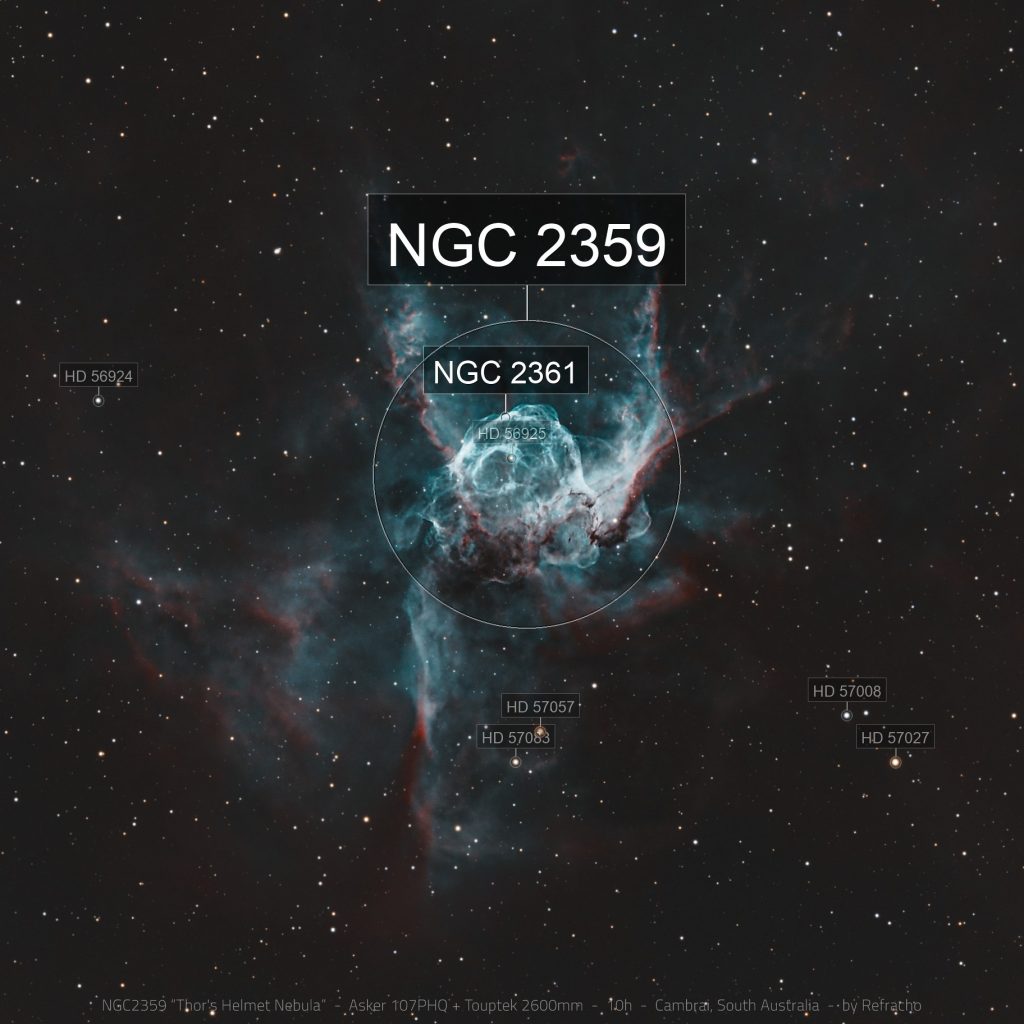Acquisition Details
- Dates: January 23 & 26, 2025
- Filters & Exposure:
- Antlia Hα 7 nm 36 mm : 62 × 300″ (5h 10m)
- Antlia OIII 7 nm 36 mm: 52 × 300″ (4h 20m)
- Total Integration: 9h 30m
- Moon Conditions: Avg. Moon age 23.3 days, phase 23%
- Imaging Parameters:
- RA center: 07h 18m 36s
- DEC center: −13° 13′ 23″
- Pixel scale: 1.04″/pixel
- Orientation: 79.57°
- Field radius: 0.58°
- Location: Meldanda, Cambrai (South Australia)


Introduction
In the southern constellation Canis Major, about 12 000 light-years from Earth, lies a cosmic structure that seems almost mythological — NGC 2359, better known as Thor’s Helmet.
This striking emission nebula is a Wolf–Rayet bubble, sculpted by intense stellar winds from a dying massive star. The supersonic outflow slams into the surrounding interstellar gas, inflating a shell of glowing hydrogen and oxygen that resembles the Norse god’s winged helmet.
Even under a modest focal length, Thor’s Helmet is remarkably detailed: the delicate shock fronts and bubble-like extensions reveal the chaotic beauty of stellar death.
Captured from the quiet skies of South Australia, this image merges science and mythology in a single frame of glowing plasma and starlight.
Processing Overview
Processing for this target was relatively straightforward.
The dataset was clean and well-tracked, allowing for a smooth calibration and integration workflow in PixInsight. Standard preprocessing was completed using WBPP, followed by a linear noise reduction and careful background extraction.
The color composition used a HOO palette, mapping Hα to red and OIII to both green and blue channels.
Rather than pushing the saturation aggressively, I focused on achieving a balanced color contrast — preserving the oxygen’s teal glow and the faint reddish filaments tracing the outer shock fronts.
A touch of LocalHistogramEqualization (LHE) and CurvesTransformation was used to enhance structural contrast without losing the subtle gradients within the bubble. The final result maintains a natural, soft appearance that highlights both the energetic core and the diffuse nebular extensions.
Scientific and Visual Notes
Thor’s Helmet is powered by a Wolf–Rayet star (WR7) — a rare, massive star nearing the end of its life.
These stars are known for their fierce stellar winds, which can reach speeds of over 2 000 km/s, stripping away their outer layers and enriching the surrounding space with heavy elements.
The Hα emission reveals the ionized hydrogen shell, while the OIII emission dominates the inner bubble, giving the nebula its striking turquoise color.
The entire structure spans roughly 30 light-years across — large enough to engulf our entire Solar System many times over.
Visually, the shape is both violent and elegant: a cosmic storm frozen in time, radiating the final breath of a dying sun.
Final Remarks
Sometimes astrophotography challenges come not from data complexity but from capturing beauty in simplicity.
Thor’s Helmet doesn’t demand extreme processing — it tells its story through form and color alone.
Under the calm skies of South Australia, it’s easy to forget that what we see here is the result of unimaginable power: a massive star burning its last fuel, blowing a shimmering bubble of gas into the void.
A fitting name indeed — the helmet of a god forged in the fire of a dying star.